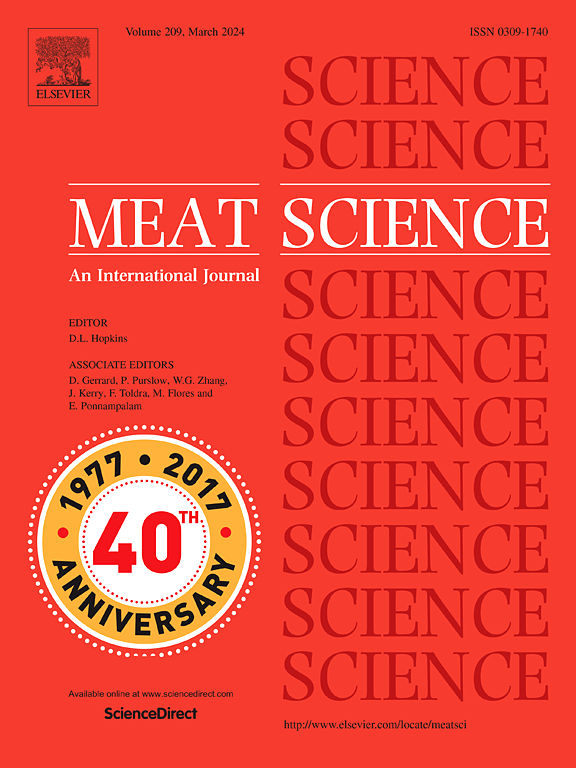Investigating the potential of NIR spectroscopy for quality assessment of vacuum-packed and unpackaged sliced Iberian ham
IF 7.1
1区 农林科学
Q1 Agricultural and Biological Sciences
引用次数: 0
Abstract
Near infrared spectroscopy (NIRS) is an extremely useful tool for quality control and traceability in the agri-food industry, particularly for high-value products such as 100 % ‘black seal’ sliced Iberian ham. The aim of this research was to study the feasibility of using NIRS technology to authenticate the quality of vacuum-packed and unpackaged sliced Iberian ham (59 black seal, 62 red seal, 56 green seal and 55 white seal samples), based on the development of predictive NIRS models for determining the fatty acid profile of the product. In this study, we used a bench-top instrument designed for laboratory applications, along with three portable near infrared (NIR) sensors with different optical configurations and technical specifications, suitable for in situ analysis. Regression models were formulated using NIR spectra and applying various signal pre-treatment methods. For the unpackaged samples, the best models achieved residual predictive deviation for cross-validation (RPDcv) values of 1.85, 1.82, and 1.87 for palmitic, stearic, and oleic acids respectively, using the bench-top sensor. The linear variable filters (LVF) instrument proved to be the best instrument for in situ analysis, with RPDcv values of 1.38, 1.28, and 1.42, for the three fatty acids analysed. For the vacuum-packed product and the LVF sensor, the RPDcv values for the three fatty acids studied ranged between 1.37 and 1.46. The findings are encouraging for the sliced Iberian ham sector, highlighting the use of NIRS for the control of premium products. Nevertheless, further studies are needed to improve the prediction models and make them applicable.
研究近红外光谱在真空包装和非包装伊比利亚火腿切片质量评价中的潜力
近红外光谱(NIRS)是农业食品工业中质量控制和可追溯性的非常有用的工具,特别是对于高价值产品,如100%“黑海豹”切片伊比利亚火腿。本研究的目的是研究利用近红外光谱技术鉴定真空包装和未包装的伊比利亚火腿切片(59个黑封、62个红封、56个绿封和55个白封样品)质量的可行性,基于预测近红外光谱模型的开发,以确定产品的脂肪酸谱。在这项研究中,我们使用了一个为实验室应用而设计的台式仪器,以及三个具有不同光学配置和技术规格的便携式近红外(NIR)传感器,适用于现场分析。利用近红外光谱和各种信号预处理方法建立了回归模型。对于未包装样品,使用台式传感器,最佳模型对棕榈酸、硬脂酸和油酸的交叉验证残余预测偏差(RPDcv)分别为1.85、1.82和1.87。线性可变过滤器(LVF)仪器被证明是原位分析的最佳仪器,对所分析的三种脂肪酸的RPDcv值分别为1.38、1.28和1.42。对于真空包装产品和LVF传感器,所研究的三种脂肪酸的RPDcv值在1.37到1.46之间。研究结果对伊比利亚火腿切片部门来说是令人鼓舞的,突出了近红外光谱用于控制优质产品的使用。然而,需要进一步的研究来改进预测模型并使其适用。
本文章由计算机程序翻译,如有差异,请以英文原文为准。
求助全文
约1分钟内获得全文
求助全文
来源期刊

Meat Science
工程技术-食品科技
CiteScore
12.60
自引率
9.90%
发文量
282
审稿时长
60 days
期刊介绍:
The aim of Meat Science is to serve as a suitable platform for the dissemination of interdisciplinary and international knowledge on all factors influencing the properties of meat. While the journal primarily focuses on the flesh of mammals, contributions related to poultry will be considered if they enhance the overall understanding of the relationship between muscle nature and meat quality post mortem. Additionally, papers on large birds (e.g., emus, ostriches) as well as wild-captured mammals and crocodiles will be welcomed.
 求助内容:
求助内容: 应助结果提醒方式:
应助结果提醒方式:


